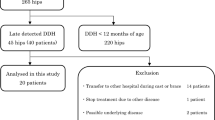Abstract
One hundred sixty-two neonates with sonographically diagnosed developmental dysplasia of the hip (200 hips) according to the method of Graf were treated with a Pavlik harness until sonographic maturation was reached. Eight patients (12 hips) treated with closed reduction and retention in a bilateral hip spica cast were included. When the children started to walk their acetabular indices were assessed and demonstrated low-grade dysplasia in 26% and high-grade dysplasia in 6% according to the criteria of Tönnis and Brunken. We discuss the current sonographic criteria defining treatment-induced normalization and the adequacy of the length of treatment. We conclude that despite normal values at the end of treatment dysplasia may develop, which necessitates further radiological monitoring of all hips initially rated at risk on sonography. When to end monitoring, however, remains to be determined.
Similar content being viewed by others
References
Castelein RD, Sauter AJM, de Vlieger M, van Linge B (1992) Natural history of ultrasound hip abnormalities in clinically normal newborns. J Pediatr Orthop 12:423–427
Fettweis E (1968) Sitz-Hock-Stellungs-Gips bei Hüftgelenks-dysplasien. Arch Orthop Trauma Surg 63:38–51
Graf R (1989) Sonographie der Säuglingshüfte. Enke, Stuttgart
Krämer J (1982) Konservative Behandlung kindlicher Luxationshüften. Enke, Stuttgart
Merk H, Wissel H (1992) Experimentelle und klinische Ultraschalluntersuchungen von Säuglingshüften im Normgrenzbereich. Ultraschall Klin Prax 7:182
Pavlik A (1957) Die funktionelle Behandlungsmethode mittels Riemenbügel als Prinzip der konservativen Therapie der angeborenen Hüftgelenksverrenkungen der Säuglinge. Z Orthop 89:341–352
Salter RB, Kostuik J, Dallas S (1969) Avascular necrosis of the femoral head as a complication of treatment for congenital dislocation of the hip in young children. A clinical and experimental investigation. Can J Surg 12:44–61
Tachdjian MO (1990) Congenital dislocation of the hip. In: Pediatric Orthopedics. Saunders, Philadelphia, pp 297–548
Tönnis D (1978) Huftluxation und Hüftkopfnekrose. Enke, Stuttgart
Tönnis D (1984) Die angeborene Hüftdysplasie und Hüftluxation im Kindes- und Erwachsenenalter. Springer, Berlin Heidelberg New York
Tönnis D, Brunken D (1968) Eine Abgrenzung normaler und pathologischer Hüftpfannendachwinkel zur Diagnose der Hüftdysplasie. Arch Orthop Trauma Surg 64:197–228
Tönnis D, Kuhlmann GP (1968) Untersuchungen über die Haufigkeit von Häuftkopfnekrosen bei Spreizhosenbehandlung und verschiedenen konservativen Behandlungsmethoden der angeborenen Hüftdysplasie und Hüftluxation. Z Orthop 106:651–672
Author information
Authors and Affiliations
Rights and permissions
About this article
Cite this article
Rachbauer, F., Sterzinger, W., Klestil, T. et al. Acetabular development following early treatment of hip dysplasia by Pavlik harness. Arch Orthop Trauma Surg 113, 281–284 (1994). https://doi.org/10.1007/BF00443818
Received:
Issue Date:
DOI: https://doi.org/10.1007/BF00443818




